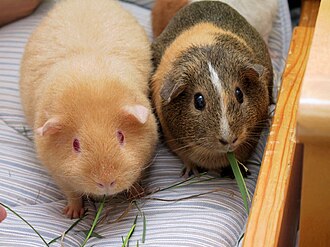Guinea pig
Guinea pigs (Cavia porcellus) are a kind of rodent. They are not pigs and are not from Guinea. The reason for why this is the name is unclear. They are also called cavies.[1] They are domesticated animals which originated in the Andes.
| Guinea pig | |
|---|---|

| |
| Two adult guinea pigs | |
| Conservation status | |
| Scientific classification | |
| Kingdom: | Animalia |
| Phylum: | Chordata |
| Order: | Rodentia |
| Family: | Caviidae |
| Genus: | Cavia |
| Species: | C. porcellus
|
| Binomial name | |
| Cavia porcellus | |
| Synonyms | |
| |
Studies on biochemistry and hybridization suggest they are descendants of a closely related species of cavy. They do not occur naturally in the wild.[2][3]
Guinea pigs as pets
In many parts of the world, people keep them as pets. In Peru, Bolivia, Ecuador and several other countries, they are raised for food. The first people who domesticated the animals, did it for food. Besides being a pet and a source of food, in some places people think guinea pigs keep bad spirits away. In Quechua, the language of some the native tribes of Peru, they are called quivi. The Spanish-speaking people of the region call them cuy (plural: cuyes).
Name
This perception of pigginess occurred in many languages other than English; the German word for them is Meerschweinchen, literally "little sea pigs" (sailing ships stopping to reprovision in the New World would pick up stores of guinea pigs, which provided an easily transportable source of fresh meat), the Russian and Polish word for them is similar, "morskaya svinka" (Морская свинка) and "świnka morska" respectively, meaning also "little sea pig" (it comes from archaic use of the word to mean "overseas"). However, this perception of pigginess is not universal to all languages or cultures. For example, the common Spanish term is 'conejillo de Indias' (Indian bunny rabbit).
Housing and breeding guinea pigs
Guinea pigs need large open air cages in which to romp and frolic. They should have a diet of 1/8 cup of high quality grass-based guinea-pig pellets daily, as per manufacturer’s instructions. They should also have unlimited grass hay, which keeps their teeth trimmed, and at least one cup of a variety of veggies. Guinea pigs like to be held in hand. Guinea pigs should be kept in cages larger than 7.5 square feet or 10.5 square feet for 2 pigs. They should always have at least one friend as guinea pigs are social animals.[4] Breeding guinea pigs are not recommended as the rate of pregnancy complications is high.[5]
For their diet guinea pigs generally prefer hay, fresh fruits and vegetables.[6]
Other uses of the term
Guinea pig is also slang for a person who is the first to try something.[7] It can also mean the subject of an experiment. This is because guinea pigs are used by biologists as model organisms.
Guinea Pig Media
This is one of the guinea pig sounds described on the Guinea Pig Wikipedia page. Its original location is on the www.GuineaPigManual.com website.
Specimen of guinea pig skull prepared by the bone maceration technique and on display at the Museum of Veterinary Anatomy, FMVZ USP.This file was published as the result of a partnership between the Museum of Veterinary Anatomy FMVZ USP, the RIDC NeuroMat and the Wikimedia Community User Group Brasil. This GLAM project is reported.Photography: Museum of Veterinary Anatomy FMVZ USPAuthor: Wagner
Guinea pigs in a petting zoo
Pregnant sow one week before delivering three pups
References
| Wikispecies has information on: Cavia (Caviinae). |
| Wikimedia Commons has media related to Lua error in Module:Commons_link at line 62: attempt to index field 'wikibase' (a nil value).. |
- ↑ Bradford, Alina (April 28, 2015). "Guinea Pig Facts". Live Science. Retrieved May 16, 2023.
- ↑ Weir, Barbara J. (1974). "Notes on the origin of the domestic guinea-pig". In Rowlands, I.W.; Weir, Barbara J. (eds.). The biology of hystricomorph rodents. Academic Press. pp. 437–446. ISBN 0-12-6133336.
- ↑ Nowak, Ronald M. (1999). Walker's mammals of the world, 6th edition. Johns Hopkins University Press. ISBN 0-8018-5789-9.
- ↑ Smith-Iversen, Nicklas (2022-08-17). "Marsvin som kjæledyr: Alt du må vite om å ha marsvin". Dyreliv.no (in norsk bokmål). Retrieved 2022-08-17.
- ↑ "Guinea Pig Allergies And Treatment". Archived from the original on 2015-12-05. Retrieved 2015-10-30.
- ↑ "How To Take Care Of A Guinea Pig". Archived from the original on 2016-06-27. Retrieved 2015-10-30.
- ↑ "Guinea Pigs". Smithills Open Farm. Retrieved 2024-08-02.







